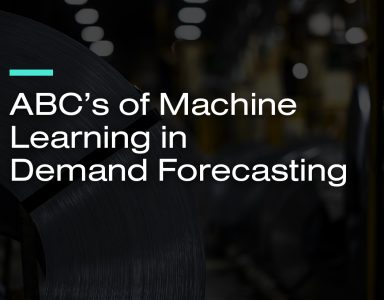
As I walked the floor at this year’s APICS conference and sat through a variety of educational sessions, I was reminded of a phrase I heard recently:
“Data is becoming a new natural resource.”
The statistics are quite mind-boggling. According to Domo, over 2.5 quintillion bytes of data are created every single day, and it’s only going to grow from there. By 2020, it’s estimated that 1.7MB of data will be created every second for every person on earth.
Unfortunately, when it comes to demand forecasting, a large part of this data is going underutilized.
The complexities of demand forecasting have challenged businesses for decades. Traditionally, the process tends to be more of an art than a science and one that often relies heavily on outdated historical data. But today with vast volumes of real-time data readily available, demand forecasting should, in theory, be getting easier and more accurate. But it’s not.
Why? Well, the fact remains that most businesses aren’t equipped to leverage the volume and diversity of today’s data. For the most part, it seems that manual work and spreadsheets are still impeding companies from capturing the value of available data.
Take the furniture manufacturer I met at the show who sells products online through partnerships with major e-commerce companies. At one point in the not so distant past, this organization’s demand forecasting involved working with limited internal data that could be easily manipulated on a spreadsheet. Today, it involves working with slews of both internal data and external data provided by their various e-commerce partners. Doubling their data rapidly overwhelmed this company’s old way of planning by spreadsheet.
Imagine what will happen when this organization and others like it realize that they need to integrate other big data like weather forecast and economic outlooks into their planning processes. Things get exponentially more complicated.
What today’s organizations need in order to take advantage of our “new natural resource” are advanced supply chain planning solutions. Platforms that create a common planning language across the entire spectrum of supply chain planning—inventory forecasting, planning, and optimization; sales and operations planning (S&OP); demand forecasting and planning; supply planning; production and capacity planning; and multi-location planning. Software that can integrate and store vast amounts of data and use rules and advanced algorithms to turn that data into knowledge and action.
The time has come to go beyond traditional forecasting methods so that today’s companies can capitalize on the excessive amounts of readily available data to solve real business problems. I’m looking forward to helping current and future DemandCaster clients harness the power of their data and begin exploring with advanced technologies like AI and machine learning might mean to them in the very near future.
Contact us if you would like to learn more about DemandCaster and how it can help you forecast and plan demand with consensus and data-driven insight.
Watch our video.


